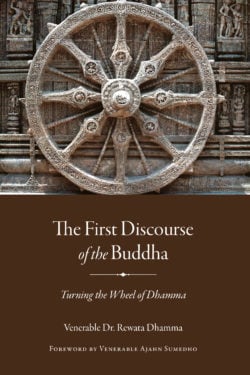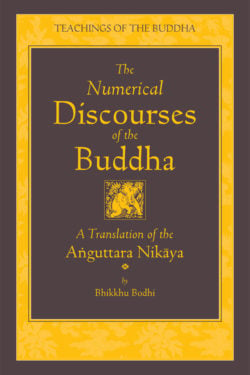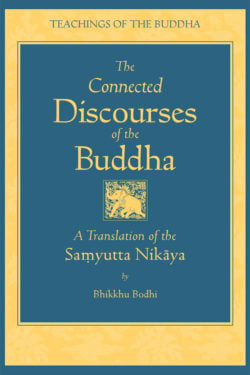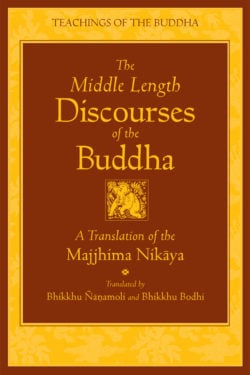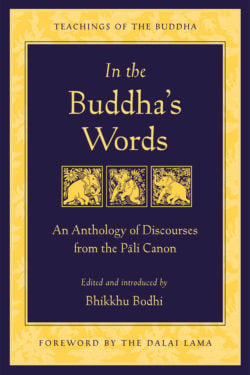
NOBLE TRUTHS, NOBLE PATH
Bhikkhu Bodhi’s newest anthology!
Brilliantly translated by Bhikkhu Bodhi, this anthology of suttas from the Saṃyutta Nikāya takes us straight to the heart of the Buddha’s teaching on liberation through the four noble truths and the noble eightfold path—the two mainstays of Buddhist doctrine that illuminate the nature of things by generating direct insight into the teachings. These suttas all pertain to the ultimate good, the attainment of nibbāna or liberation. They illuminate the Buddha’s radical diagnosis of the human condition—and more broadly, the condition of all sentient existence—in light of the four noble truths. They underscore the pervasive flaws inherent in the round of rebirths, trace our existential predicament to its deepest roots, and lay out the path to unraveling our bondage and winning irreversible release. Ven. Bodhi arranged the chapters, each with its own introduction, to provide an overview of the Dhamma that mirrors the four noble truths, thus enabling students of Early Buddhism to see into the heart of the Buddha’s teachings as directly and clearly as possible.
For those interested in the Pāli language, Bhikkhu Bodhi provides linguistic and grammatical explanations of the suttas included in this book in his Reading the Buddha’s Discourses in Pāli.
Learn more about the Teachings of the Buddha series.
- Hardcover
- 200 pages, 6 x 8.5 inches
- $44.95
- ISBN 9781614297987
- Paperback
- 200 pages, 6 x 9 inches
- $19.95
- ISBN 9781614299189
- eBook
- 200 pages
- $14.99
Discover More
The First Discourse of the Buddha
Two months after the Buddha attained enlightenment under the Bodhi Tree, he traveled to Sarnath, India. There he delivered his first discourse to a group of five ascetics in Deer Park. This teaching, known as the “First Turning of the Wheel of Dhamma” or the Dhammacakka Sutta, contains the foundational teachings of all Buddhism. In it the Buddha explains the way to freedom from suffering through the teachings of the Four Noble Truths and the Noble Eightfold Path.
With this translation and its verse-by-verse commentary, Dr. Dhamma brings fresh insight to the Dhammacakka Sutta. Drawing on the rich Burmese monastic scholarly tradition and his own experiences as a vipassanā practitioner, Dr. Dhamma makes clear the precise steps necessary for the realization of the teachings contained in the Buddha’s first discourse.
The Signless and the Deathless
An insightful examination of the end of suffering drawing much-needed attention to two overlooked factors of Nirvana: signlessness and deathlessness. Includes a foreword by Bhante Gunaratana.
Nirvana is at once a critical part of the Buddhist path and a concept difficult to fully understand for Buddhist practitioners. Canonical texts broach this mysterious and essential idea in a variety of ways, whether in the form of metaphor or literary description. In The Signless and the Deathless: On the Realization of Nirvana, scholar-monk Bhikkhu Anālayo sheds light on two key aspects of Nirvana that have gone underappreciated: signlessness and deathlessness.
Commanding an extraordinary mastery of canonical Buddhist languages, Venerable Anālayo breaks new ground, or rediscovers old ground, by presenting a new way of approaching Nirvana, based on the Buddha’s teachings on how our minds construct experience. This novel treatment, backed up by meticulous academic expertise, is valuable for scholars and practitioners alike.
Through practicing bare awareness…realizing Nirvana entails “a complete stepping out of the way the mind usually constructs experience.”
Buddhist Suttas for Recitation
Bring the Buddha’s teachings more deeply into your life.
Buddhist Suttas for Recitation provides everything you need to begin and maintain a practice of contemplative recitation and reflection. These practices will deepen your connection to the Buddha, strengthen your faith in the Path, and nurture your intellectual understanding of the Dhamma.
This unique volume includes carefully chosen discourses of the Buddha from the Pali Canon—presented in inspiring and accessible English with accompanying Pali—that convey the essence of the Dhamma. The introductory material explains the relationship between meditation and devotional practice, offers instructions on setting up a home altar, and gives advice on how to use these texts to enhance your spiritual development.
108 Metaphors for Mindfulness
This engaging and accessible little book is filled with both humor and profound teaching. It presents 108 metaphors for mindfulness, meditation practice, the nature of the self, change, deep acceptance, and other related concepts that Dr. Kozak has cultivated over twenty-five years of meditating, practicing yoga, and working as a clinical psychologist.
Metaphors are indispensable to understanding mindfulness, and to help deeply internalize it and make it a part of everyday life. These mentally catchy images can motivate us to practice, show us how and where to bring mindfulness to life in our personal experience, and help us employ powerful methods for transformation.
This book was previously published under the title Wild Chicken and Petty Tyrants.
The Long Discourses of the Buddha
This book offers a complete translation of the Dīgha Nikāya, the long discourses of the Buddha, one of the major collections of texts in the Pali Canon, the authorized scriptures of Theravada Buddhism. This collection—among the oldest records of the historical Buddha’s original teachings, given in India two and a half thousand years ago—consists of thirty-four longer-length suttas, or discourses, distinguished as such from the middle-length and shorter suttas of the other collections.
These suttas reveal the gentleness, compassion, power, and penetrating wisdom of the Buddha. Included are teachings on mindfulness (Mahāsatipaṭṭhāna Sutta); on morality, concentration, and wisdom (Subha Sutta); on dependent origination (Mahānidrāna Sutta); on the roots and causes of wrong views (Brahmajāla Sutta); and a long description of the Buddha’s last days and passing away (Mahāparinibbāna Sutta); along with a wealth of practical advice and insight for all those travelling along the spiritual path.
Venerable Sumedho Thera writes in his foreword: “[These suttas] are not meant to be ‘sacred scriptures’ that tell us what to believe. One should read them, listen to them, think about them, contemplate them, and investigate the present reality, the present experience, with them. Then, and only then, can one insightfully know the truth beyond words.”
Introduced with a vivid account of the Buddha’s life and times and a short survey of his teachings, The Long Discourses of the Buddha brings us closer in every way to the wise and compassionate presence of Gotama Buddha and his path of truth.
- Learn more about the Teachings of the Buddha series.
The Numerical Discourses of the Buddha
Like the River Ganges flowing down from the Himalayas, the entire Buddhist tradition flows down to us from the teachings and deeds of the historical Buddha, who lived and taught in India during the fifth century B.C.E. To ensure that his legacy would survive the ravages of time, his direct disciples compiled records of the Buddha’s teachings soon after his passing. In the Theravāda Buddhist tradition, which prevails in Sri Lanka and Southeast Asia, these records are regarded as the definitive “word of the Buddha.” Preserved in Pāli, an ancient Indian language closely related to the language that the Buddha spoke, this full compilation of texts is known as the Pāli Canon.
At the heart of the Buddha’s teaching were the suttas (Sanskrit sūtras), his discourses and dialogues. If we want to find out what the Buddha himself actually said, these are the most ancient sources available to us. The suttas were compiled into collections called “Nikāyas,” of which there are four, each organized according to a different principle. The Dīgha Nikāya consists of longer discourses; the Majjhima Nikāya of middle-length discourses; the Saṃyutta Nikāya of thematically connected discourses; and the Aṅguttara Nikāya of numerically patterned discourses.
The present volume, which continues Wisdom’s famous Teachings of the Buddha series, contains a full translation of the Aṅguttara Nikāya. The Aṅguttara arranges the Buddha’s discourses in accordance with a numerical scheme intended to promote retention and easy comprehension. In an age when writing was still in its infancy, this proved to be the most effective way to ensure that the disciples could grasp and replicate the structure of a teaching.
In 2013, Venerable Bhikkhu Bodhi was awarded the 2013 Khyentse Foundation Prize for Outstanding Translation.
- Learn more about the Teachings of the Buddha series.
The Connected Discourses of the Buddha
This volume offers a complete translation of the Saṃyutta Nikāya, The Connected Discourses of the Buddha, the third of the four great collections in the Sutta Piṭaka of the Pāli Canon. The Saṃyutta Nikāya consists of fifty-six chapters, each governed by a unifying theme that binds together the Buddha’s suttas or discourses. The chapters are organized into five major parts.
The first, The Book with Verses, is a compilation of suttas composed largely in verse. This book ranks as one of the most inspiring compilations in the Buddhist canon, showing the Buddha in his full grandeur as the peerless “teacher of gods and humans.” The other four books deal in depth with the philosophical principles and meditative structures of early Buddhism. They combine into orderly chapters all the important short discourses of the Buddha on such major topics as dependent origination, the five aggregates, the six sense bases, the seven factors of enlightenment, the Noble Eightfold Path, and the Four Noble Truths.
Among the four large Nikāyas belonging to the Pali Canon, the Saṃyutta Nikāya serves as the repository for the many shorter suttas of the Buddha where he discloses his radical insights into the nature of reality and his unique path to spiritual emancipation. This collection, it seems, was directed mainly at those disciples who were capable of grasping the deepest dimensions of wisdom and of clarifying them for others, and also provided guidance to meditators intent on consummating their efforts with the direct realization of the ultimate truth.
The present work begins with an insightful general introduction to the Saṃyutta Nikāya as a whole. Each of the five parts is also provided with its own introduction, intended to guide the reader through this vast, ocean-like collection of suttas.
To further assist the reader, the translator has provided an extensive body of notes clarifying various problems concerning both the language and the meaning of the texts.
Distinguished by its lucidity and technical precision, this new translation makes this ancient collection of the Buddha’s discourses accessible and comprehensible to the thoughtful reader of today. Like its two predecessors in this series, The Connected Discourses of the Buddha is sure to merit a place of honour in the library of every serious student of Buddhism.
- Learn more about the Teachings of the Buddha series.
The Middle Length Discourses of the Buddha
This book offers a complete translation of the Majjhima Nikāya, or Middle Length Discourses of the Buddha, one of the major collections of texts in the Pali Canon, the authorized scriptures of Theravāda Buddhism. This collection—among the oldest records of the historical Buddha’s original teachings—consists of 152 suttas or discourses of middle length, distinguished as such from the longer and shorter suttas of the other collections. The Majjhima Nikāya might be concisely described as the Buddhist scripture that combines the richest variety of contextual settings with the deepest and most comprehensive assortment of teachings. These teachings, which range from basic ethics to instructions in meditation and liberating insight, unfold in a fascinating procession of scenarios that show the Buddha in living dialogue with people from many different strata of ancient Indian society: with kings and princes, priests and ascetics, simple villagers and erudite philosophers. Replete with drama, reasoned argument, and illuminating parable and simile, these discourses exhibit the Buddha in the full glory of his resplendent wisdom, majestic sublimity, and compassionate humanity.
The translation is based on an original draft translation left by the English scholar-monk Bhikkhu Ñāṇamoli, which has been edited and revised by the American monk Bhikkhu Bodhi, who provides a long introduction and helpful explanatory notes. Combining lucidity of expression with accuracy, this translation enables the Buddha to speak across twenty-five centuries in language that addresses the most pressing concerns of the contemporary reader seeking clarification of the timeless issues of truth, value, and the proper conduct of life.
Winner of the 1995 Choice Magazine Outstanding Academic Book Award, and the Tricycle Prize for Excellence in Buddhist Publishing for Dharma Discourse.
- Learn more about the Teachings of the Buddha series.
In the Buddha’s Words
This landmark collection is the definitive introduction to the Buddha’s teachings—in his own words. The American scholar-monk Bhikkhu Bodhi, whose voluminous translations have won widespread acclaim, here presents selected discourses of the Buddha from the Pali Canon, the earliest record of what the Buddha taught. Divided into ten thematic chapters, In the Buddha’s Words reveals the full scope of the Buddha’s discourses, from family life and marriage to renunciation and the path of insight. A concise, informative introduction precedes each chapter, guiding the reader toward a deeper understanding of the texts that follow.
In the Buddha’s Words allows even readers unacquainted with Buddhism to grasp the significance of the Buddha’s contributions to our world heritage. Taken as a whole, these texts bear eloquent testimony to the breadth and intelligence of the Buddha’s teachings, and point the way to an ancient yet ever-vital path. Students and seekers alike will find this systematic presentation indispensable.
Learn more about the Teachings of the Buddha series.
The Buddha’s Teachings on Social and Communal Harmony
In this volume acclaimed scholar-monk Bhikkhu Bodhi has collected and translated the Buddha’s teachings on conflict resolution, interpersonal and social problem-solving, and the forging of harmonious relationships. The selections, all drawn from the Pāli Canon, the earliest record of the Buddha’s discourses, are organized into ten thematic chapters. The chapters deal with such topics as the quelling of anger, good friendship, intentional communities, the settlement of disputes, and the establishing of an equitable society. Each chapter begins with a concise and informative introduction by the translator that guides us toward a deeper understanding of the texts that follow.
In times of social conflict, intolerance, and war, the Buddha’s approach to creating and sustaining peace takes on a new and urgent significance. Even readers unacquainted with Buddhism will appreciate these ancient teachings, always clear, practical, undogmatic, and so contemporary in flavor. The Buddha’s Teachings on Social and Communal Harmony will prove to be essential reading for anyone seeking to bring peace into their communities and into the wider world.
Includes a prologue and epilogue by Hozan Alan Senauke.
- Learn more about the Teachings of the Buddha series.
Great Disciples of the Buddha
A perennial favorite, Great Disciples of the Buddha is now relaunched in our best-selling Teachings of the Buddha series.
Twenty-four of the Buddha’s most distinguished disciples are brought to life in ten chapters of rich narration. Drawn from a wide range of authentic Pāli sources, the material in these stories has never before been assembled in a single volume. Through these engaging tales, we meet all manner of human beings—rich, poor, male, female, young, old—whose unique stories are told with an eye to the details of ordinary human concerns. When read with careful attention, these stories can sharpen our understanding of the Buddhist path by allowing us to contemplate the living portraits of the people who fulfilled the early Buddhist ideals of human perfection. The characters detailed include:
- Sāriputta
- Nandā
- Mahāmoggallāna
- Mahākassapa
- Ānanda
- Isidāsī
- Anuruddha
- Mahākaccāna
- Aṅgulimāla
- Visākhā
- and many more.
Conveniently annotated with the same system of sutta references used in each of the other series volumes, Great Disciples of the Buddha allows the reader to easily place each student in the larger picture of Buddha’s life. It is a volume that no serious student of Buddhism should miss.
- Learn more about the Teachings of the Buddha series.
The Suttanipāta
The Suttanipāta, or “Group of Discourses” is a collection of discourses ascribed to the Buddha that includes some of the most popular suttas of the Pāli Canon, among them the Loving-Kindness Sutta. The suttas are primarily in verse, though several are in mixed prose and verse. The Suttanipāta contains discourses that extol the figure of the muni, the illumined sage, who wanders homeless completely detached from the world. Other suttas, such as the Discourse on Downfall and the Discourse on Blessings, establish the foundations of Buddhist lay ethics. The last two chapters—the Aṭṭhakavagga (Chapter of Octads) and the Pārāyanavagga (The Chapter on the Way to the Beyond)—are considered to be among the most ancient parts of the Pāli Canon. The Aṭṭhakavagga advocates a critical attitude toward views and doctrines. The Pārāyanavagga is a beautiful poem in which sixteen spiritual seekers travel across India to meet the Buddha and ask him profound questions pertaining to the highest goal.
The main commentary, the Paramatthajotikā, relates the background story to each sutta and explains each verse in detail. The volume includes numerous excerpts from the Niddesa, an ancient commentary already included in the Pāli Canon, which offers detailed expositions of each verse in the Aṭṭhakavagga, the Pārāyanavagga, and the Rhinoceros Horn Sutta.
Translator Bhikkhu Bodhi provides an insightful, in-depth introduction, a guide to the individual suttas, extensive notes, a list of parallels to the discourses of the Suttanipāta, and a list of the numerical sets mentioned in the commentaries.
- Learn more about the Teachings of the Buddha series.


